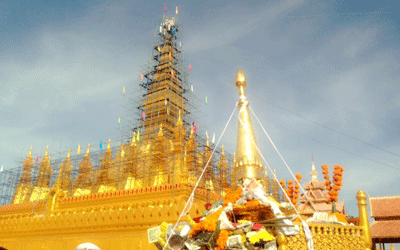Vientiane authorities yesterday placed almost 10 kilogrammes of gold atop the That Luang Stupa to mark the 450th anniversary of the stupa’s construction.
The ceremony was attended by President Bounnhang Vorachit, Vientiane Mayor Dr Sinlavong Khoutphaythoune, Deputy Minister of Information, Culture and Tourism Mr. Bouangeun Xaphouvong, monks and other Buddhists.
The gilding of the grand stupa is a historic milestone, with nine kilogrammes and nine baht weight of gold being added to the tip.
The stupa has been partially restored under the That Luang Stupa Restoration Project to mark the 450th anniversary of the iconic structure, which is being celebrated alongside the annual That Luang festival from November 12-14.
Mr. Bouangeun said the restoration involved improvements to the main structure, paintwork, garden, drainage, electrical system and other features, as well as renewing the gold coating on the main spire.
Most of the work has been finished while the project committee promised that the remaining repairs would be finished ahead of the festival. The committee is continuing to raise funds for the restoration.
The work will cost about 15 billion kip. So far the committee has received 16 kilogrammes and 44 baht of gold, and over two billion kip in cash from government and private donations.
The stupa was originally built during the ancient Khmer civilisation, when Vientiane was inhabited by people known as the Cham. Researchers believe the structure was originally a four-sided stone obelisk.
The site was built as a place for people to worship and pray to idols.
The structure was renovated on the orders of King Xaysetthathirath in the 16th century when the original site was covered with a bigger stupa. From then on the monument took the name That Luang, or Grand Stupa.
The Cham period saw the second wave of Buddhism in Laos. Under the patronage of Emperor Ashokka of India, the venerable monks Sona and Outala and five scholars brought what believers understand to be pieces of the pelvic bone of Lord Buddha to Vientiane in the Buddhist calendar year 218 (BCE). The ruler of Vientiane at that time, Lord Chanthabouly Phasitthisack, had a stupa built over the obelisk in 236 BCE. The sacred site was then named Pha Chedi Lokachulamany.
According to legend, Emperor Ashokka authorised the relics to be placed inside the That Luang stupa.
The same legend claims that the remains of Lord Buddha were distributed to all corners of the globe where there were Buddhist followers and his ashes were placed inside 84,000 stupas. This number corresponds to the 84,000 points that believers are required to study in the Buddhist scriptures.
Source: Vientiane Times



